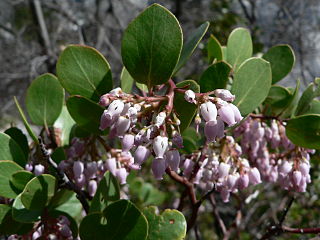
Arctostaphylos patula is a species of manzanita known by the common name greenleaf manzanita. This manzanita is native to western North America where it grows in coniferous forests at moderate to high elevations.
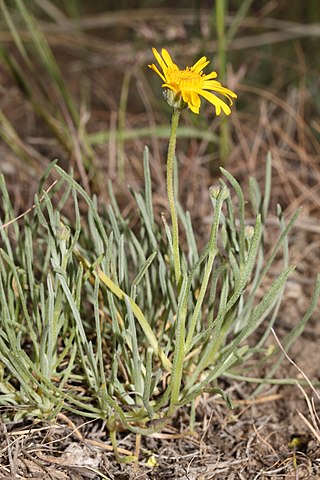
Erigeron linearis is a species of flowering plant in the family Asteraceae known by the common name desert yellow fleabane or narrow leaved fleabane. It is native to western North America.

Gnaphalium palustre, known by the common name western marsh cudweed, is a species of flowering plant in the family Asteraceae.
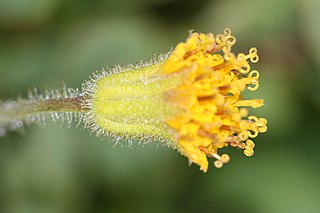
Arnica parryi is a North American species of flowering plant known by the common names Parry's arnica or nodding arnica. It is native to western Canada and the western United States as far south as Inyo County, California and McKinley County, New Mexico. It grows in temperate coniferous forests and alpine meadows in mountainous areas, primarily the Rocky Mountains, Cascades, and Sierra Nevada.
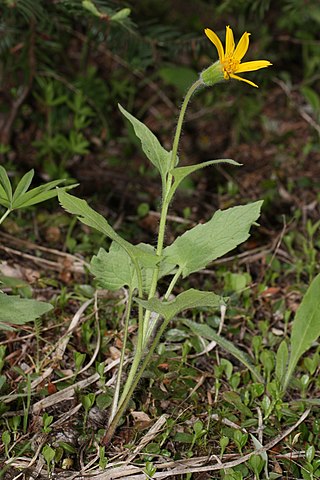
Arnica cordifolia is a species of arnica in the sunflower family, known by the common name heartleaf arnica. It is native to western North America.

Arnica sororia is a North American species of flowering plant known by the common name twin arnica. It is native to Western Canada and the Western United States. It grows in grasslands and in conifer forests, as well as the sagebrush steppe.

Cirsium brevistylum is a species of thistle known by the common names Indian thistle and clustered thistle. It is native to western North America having been found in southwestern British Columbia, Washington, Oregon, Idaho, Montana, and California.

Cirsium remotifolium is a species of thistle known by the common name fewleaf thistle. It is native to the western United States, including the Pacific Coast and possibly as far east as the Rocky Mountains, depending on which populations are treated as part of the species. It is sometimes part of the serpentine soils flora. This native thistle is a perennial herb growing up to about 1.5 meters tall. The leaves are borne on spiny petioles and are toothed or lobed, the lowest leaves at the base of the stem reaching 50 centimeters in length. The inflorescence is made up of clustered flower heads which are lined with spiny phyllaries. The head is filled with white or purple flowers up to 2.5 centimeters long. The fruit is an achene a few millimeters long topped with a pappus up to about 2 centimeters in length.

Solidago nemoralis is a species of flowering plant in the family Asteraceae. It is native to North America, where it is widely found in Canada and the United States. Its common names include gray goldenrod, gray-stem goldenrod, old-field goldenrod, field goldenrod, prairie goldenrod, dwarf goldenrod, and dyersweed goldenrod.

Veronica wormskjoldii is a species of flowering plant in the plantain family known by the common name American alpine speedwell. It is native to much of northern and western North America, including the western United States and northern Canada, from where it grows in moist alpine habitat, such as mountain forest understory. It has a wide subarctic distribution from Alaska to Greenland.
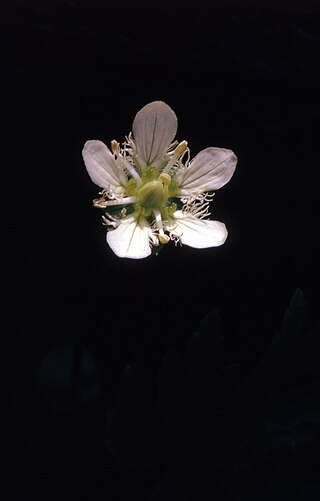
Parnassia fimbriata is a species of flowering plant in the family Celastraceae known by the common name fringed grass of Parnassus. It was first described by Joseph Banks. It is native to western North America from Alaska and northwestern Canada to the southern Rocky Mountains, where it is a plant of alpine and subalpine environments, usually in wet areas. Despite the common name, this is not a true grass.

Ranunculus eschscholtzii is a species of buttercup flower known by the common name Eschscholtz's buttercup.
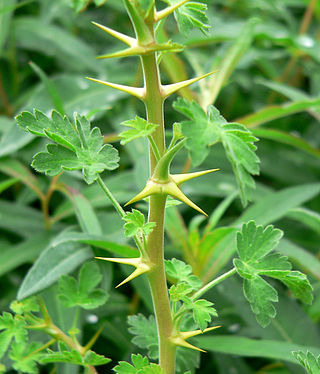
Ribes montigenum is a species of currant known by the common names mountain gooseberry, alpine prickly currant, western prickly gooseberry, and gooseberry currant. It is native to western North America from Washington south to California and east as far as the Rocky Mountains, where it grows in high mountain habitat types in subalpine and alpine climates, such as forests and talus. It is a spreading shrub growing up to 1.5 meters tall, the branching stems covered in prickles and hairs and bearing 1 to 5 sharp spines at intervals.

Rubus lasiococcus is a species of wild blackberry known by the common names roughfruit berry and dwarf bramble. It is native to western North America from British Columbia to northern California, where it grows in mountain forests. In the southern half of its range the plant is commonly found in a plant community in the understory of mountain hemlock and Shasta red fir.
Packera subnuda is a species of flowering plant in the aster family known by the common names Buek's groundsel and cleftleaf groundsel. It is native to western North America from the Northwest Territories to northern California to Wyoming, where it grows in high mountain meadows in subalpine and alpine climates.

Solidago multiradiata is a species of goldenrod known by the common names Rocky Mountain goldenrod, northern goldenrod, and alpine goldenrod. It is native to North America, where it can be found throughout the northern regions, including Alaska and most of Canada (all 3 territories plus all provinces except Prince Edward Island, including territory north of the Arctic Circle. Its distribution extends through the western United States as far south as Arizona, New Mexico, and California. It is known mostly from the subalpine and alpine climates of high mountain ranges. Its habitat includes tundra and mountain meadows.
Streptanthus gracilis is an uncommon species of flowering plant in the mustard family known by the common name alpine jewelflower.
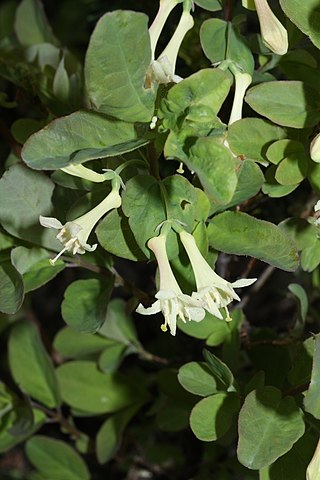
Lonicera utahensis is a species of flowering plant in the honeysuckle family known by the common names Utah honeysuckle, red twinberry, and fly honeysuckle. It is native to western North America from British Columbia, Washington (state), and Oregon, east to Alberta and Montana and south through the Rocky Mountains to Arizona and New Mexico.

Viola flettii is a species of violet known by the common name Olympic violet. Native to the northeastern and eastern Olympic Mountains of Washington in northwestern United States, it occurs on rocky outcrops and talus at subalpine and alpine elevations, i.e., from 1,340–2,000 metres (4,400–6,560 ft), and blooms from June through August. This rhizomatous herb produces a hairless stem reaching a maximum height of a few centimeters to around 15 centimeters. The basal leaves have purple-veined green reniform blades borne on petioles. Leaves on the flower stem are similar but smaller. A solitary flower is borne on a slender upright stem. It has five purplish-violet petals with yellowish bases, the lower three with purple veins. The lateral pair are bearded as is the stigma. The spur on the lowest petal is much shorter than the petal.

Smelowskia, sometimes called false candytufts, is a genus of flowering plants in the crucifer family Brassicaceae, native to mountains and arctic regions of Asia and western North America. They may or may not be of Beringian origin.



















